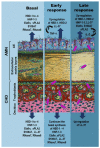Compartmentalized Innate Immune Response of Human Fetal Membranes against Escherichia coli Choriodecidual Infection
- PMID: 35328414
- PMCID: PMC8949057
- DOI: 10.3390/ijms23062994
Compartmentalized Innate Immune Response of Human Fetal Membranes against Escherichia coli Choriodecidual Infection
Abstract
An infectious process into the uterine cavity represents a major endangered condition that compromises the immune privilege of the maternal-fetal unit and increases the risk for preterm birth (PTB) and premature rupture of membranes (PROM). Fetal membranes are active secretors of antimicrobial peptides (AMP), which limit bacterial growth, such as Escherichia coli. Nevertheless, the antibacterial responses displayed by chorioamniotic membranes against a choriodecidual E. coli infection have been briefly studied. The objective of this research was to characterize the profile of synthesis, activity, and spatial distribution of a broad panel of AMPs produced by fetal membranes in response to E. coli choriodecidual infection. Term human chorioamniotic membranes were mounted in a two independent compartment model in which the choriodecidual region was infected with live E. coli (1 × 105 CFU/mL). Amnion and choriodecidual AMP tissue levels and TNF-α and IL-1β secretion were measured by the enzyme-linked immunosorbent assay. The passage of bacterium through fetal membranes and their effect on structural continuity was followed for 24 h. Our results showed that E. coli infection caused a progressive mechanical disruption of the chorioamniotic membranes and an activated inflammatory environment. After the challenge, the amnion quickly (2-4 h) induced production of human beta defensins (HBD)-1, HBD-2, and LL-37. Afterwards (8-24 h), the amnion significantly produced HBD-1, HBD-2, HNP-1-3, S100A7, sPLA2, and elafin, whereas the choriodecidua induced LL-37 synthesis. Therefore, we noticed a temporal- and tissue-specific pattern regulation of the synthesis of AMPs by infected fetal membranes. However, fetal membranes were not able to contain the collagen degradation or the bacterial growth and migration despite the battery of produced AMPs, which deeply increases the risk for PTB and PROM. The mixture of recombinant HBDs at low concentrations resulted in increased bactericidal activity compared to each HBD alone in vitro, encouraging further research to study AMP combinations that may offer synergy to control drug-resistant infections in the perinatal period.
Keywords: alpha defensins; antimicrobial peptides; beta defensins; collagen degradation; genitourinary infection; innate defense; innate immunity; maternal–fetal interface.
Conflict of interest statement
The authors declare that there is no conflict of interest regarding the publication of this paper.
Figures







References
-
- Chawanpaiboon S., Vogel J.P., Moller A.-B., Lumbiganon P., Petzold M., Hogan D., Landoulsi S., Jampathong N., Kongwattanakul K., Laopaiboon M., et al. Global, Regional, and National Estimates of Levels of Preterm Birth in 2014: A Systematic Review and Modelling Analysis. Lancet Glob. Health. 2019;7:e37–e46. doi: 10.1016/S2214-109X(18)30451-0. - DOI - PMC - PubMed
-
- Sáez-López E., Guiral E., Fernández-Orth D., Villanueva S., Goncé A., López M., Teixidó I., Pericot A., Figueras F., Palacio M., et al. Vaginal versus Obstetric Infection Escherichia coli Isolates among Pregnant Women: Antimicrobial Resistance and Genetic Virulence Profile. PLoS ONE. 2016;11:e0146531. doi: 10.1371/journal.pone.0146531. - DOI - PMC - PubMed
MeSH terms
Substances
Grants and funding
LinkOut - more resources
Full Text Sources
Medical
Research Materials

